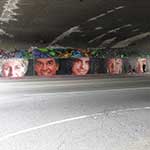A walk-through of the Sunken City
With a GoPro strapped onto my head, I walked through the Sunken City to give you a virtual tour of what it looks like if you can't make it here yourself. Please note the beautiful street art, amazing ocean view and the ruins of old housing foundations and roads.
Enrique Duarte is a 13-year-old boy diagnosed with Autism, but his condition is not like what most people think.
The City of Los Angles was once named the mural city of the world. After a citywide ban on murals was lifted, murals in the city make a return.
Thanks in part to 2012′s international hit-“Gangnam Style” by Psy, Korean Pop music or “K-pop” is booming in the global music scene. A K-pop festival recently took place in Los Angeles at the LA Memorial Coliseum. The crowd of the festival was diverse with more non-Korean people than in past years, suggesting that K-pop is booming in the global music scene.
Sergio Ochoa and his friends are spray-painting a block of concrete that used to be part of a residential apartment block. Painting with blue and white spray-paint cans, he is contributing to the outdoor art gallery that locals now call the Sunken City.
“This is my second time coming here, and I am just painting something for my friends,” said Ochoa. “It’s pretty cool because there are a lot of crazy paintings.”
His friends came along for the adventure.
“It’s my first time coming here, and I actually really like it,” said Tiara Palazuelos. “I like how the paintings look and I want to learn. It seems like a lot of people come here to be artists.”
Indeed, almost every piece of cement that used to be the foundation for a building is adorned with words, paintings and patterns. However, this hidden gem is secret and fenced off, because of the various dangers that linger underneath the ground.
The Sunken City of San Pedro, Calif., wasn’t always a “sunken city.” Before 1929, it was a residential community built by George Peck. According to a publication by the Pacific Section of the Society for Sediment Geology (SEPM), the land around Point Fermin started moving in 1929, with continuous movement since then. The slide started as a simple block slide and comprised approximately 10.5 acres.
On Jan. 2, 1929, “a waterline broke under the Ocean View Inn on Paseo del Mar, about 200 feet west of Carolina Street,” the article says. “On January 10, 1929, a gas line broke in the same building. Breaking of water lines, street improvements and dislocation of residents and garages continued through most of 1929.”
On May 18, 1929, the Los Angeles Times reported “first discernible January 2, the crack runs from the sea cliffs at Point Fermin inland one-half block and back to sea at Pacific avenue and Paseo del Mar, taking in five acres. Since then, the dozen dwellings and apartment houses to the seaward have experienced successive breaks in gas and water lines.”
“What happens to bentonite when it gets wet is that it weakens even more,” said John Nieto of the Palos Verdes Peninsula Land Conservancy. “With the undercut of the waves from the cliff, the water seeped into the layer, and it became so heavy that it began moving into the ocean. Thankfully, they had enough time to remove people from their homes before the landslide.”
The Oxford Dictionary defines bentonite as “a kind of absorbent clay formed by the breakdown of volcanic ash, used especially as a filler.”
On the day after the initial slide, the Los Angeles Times reported that “yesterday, the edge of the crack caved in in front of Charles Fulton’s house in at 602 Shephard street, leaving a deep hole ten feet long and three feet across.”
According to the California Geological Survey, landslides in California are common due to the tectonically active environment.
“In general, landslides are more common where slopes are steep and rocks are weak, and these conditions are all too common in southern California,” the survey says. This is the case with the Paseo del Mar region.
The Society for Sedimentary Geology says “records of the Point Fermin Landslide provided little previous records relative to geotechnical inspection or investigation, geologic or soil reports regarding instabilities within the site area.” This means that no proper research was conducted to determine whether building was safe there.
Nieto agreed with this: “If we would’ve had the codes we have now, no houses would’ve been built there.”
Now, what remains are residences, old pipes, housing foundations and ruins of old railroad tracks. However, that is exactly what attracts hikers, adventurers and graffiti artists to a place that evokes an apocalyptic world.
It is fenced off and adorned with a “No Trespassing” sign, but curious people have found a way in through a hole in the fence or climbing over the fence with help of a fallen tree trunk. Walking through a flat piece of land that offers breathtaking views of the Pacific Ocean, one suddenly comes across a big hole in the ground -- the Sunken City.
SEPM says that “the Point Fermin bluff area is covered with a variety of plants and more than 200 species of birds have been sited [sighted]. Whales, seals and sea lions can be seen from the trail."
Not much has changed in decades. Martin Wilson came here for the first time when he was a boy and used to visit the Sunken City with his friends to party.
“It’s been this way for 30 years,” he said. “Excellent ocean view, although people come down here to skate, film documentaries or take photos for photo shoots. It’s also a lot cleaner now.”
The cleanliness could be attributed to Wilson himself. Lately, Wilson and his girlfriend, Carrie Tautenhahn, have been coming to the Sunken City to clean up trash left behind by visitors. Tautenhahn comes here every day, although it is still considered illegal.
“I like the fact that its something that natural […], and just the idea that it used to be streets and houses and now it’s just rubble, and everyone gets something different out of it,” said Tautenhahn. “I like the exercise of climbing, the views, the animals, there’s different kind of birds… everything is amazing.”
“The cops don’t care,” said Wilson. “One time, they enlisted me to put out a bonfire in the Sunken City instead of fining me for trespassing. The fence is just a precaution but the police don’t enforce that.”
The City of Los Angeles takes necessary precautions for good reason. According to the Los Angeles Times, a woman was found dead in 2013 in the Sunken City area. In the same year, the Daily Breeze reported that a girl had fallen off the cliffs at the Sunken City, when she and her mom had trespassed the fences. The girl, 10, sustained significant head injuries. Overall, the cliffs and loose ground make it dangerous for anyone to walk around here.
This is why there are no plans to make the area more accessible to the public. All the conservancy groups have done is create a cul-de-sac for better viewing from the street. The steep cliffs and loose rocks are not safe for even the savviest climbers.
After all, the land still keeps sliding. In the past years, there have been multiple landslides around the area that have caused major cracking in highways. In 2011, a roadway in San Pedro toppled into the Pacific Ocean near the White Point Nature Preserve. The Los Angeles Times said “the roadway had broken into pieces that crumbled into the gaping holes while other sections fell into the ocean below.”
David Hayes, from the Coastal Conservancy, said that there is a big controversy about what to do with the area.
“The City of Los Angeles, its engineers and political representatives are trying to decide on a solution,” he said. “Either spend public money to replace the roadway or leave Paseo del Mar a ‘no paseo street.’”
Hayes said that there is also a debate about whether money should be used to save private residences in case of future slides, although the “respective cities allowed the building by issuing permits on these erosive coastal bluffs.”
“Often times, these residences house wealthy owners who can afford to purchase these ocean view properties and build ‘dream homes,’” he said. Spending public money on wealthy peoples’ homes sounds unreal to many paying taxes in Los Angeles.
Back in 1929, the Los Angeles Times wrote “plans are said to be developing for a proposal that the City Council condemn the affected area and dedicate it to park purposes.” Another article from the Los Angeles Times dated Aug. 23, 1929 said “proposal that the city float a bond issue of approximately $400,000 to purchase the affected area and convert it into an addition to Point Fermin Park was made.”
Part of the area had, indeed, been converted into a park, but most of the affected area became what is now known as the Sunken City. Even today, the city is spending hundreds of thousands of dollars to repair any damages by the on-going landslides.
“Every year, the city of Rancho Palos Verdes has an estimated $500,000 spent on repairs, caused by landslides, for that quarter mile section in the South Bay,” Nieto said. “Because they know that if it were gone, it would close the whole south side of the peninsula.”
Although Hayes said nothing has been learned from the fall of the Sunken City, Nieto disagreed.
“Many developments, like the development called Terranea, are required to have a certain buffer zone. Even the Trump National Golf Course has found ways to preserve the land and make it less dangerous for the public.”
For now, there are only talks about how to repair the cracked foundations near the Paseo del Mar region. And for now, the Sunken City remains a somewhat secret place, which can only be accessed through a hole in the fence and only invites the most daring and brave.



















